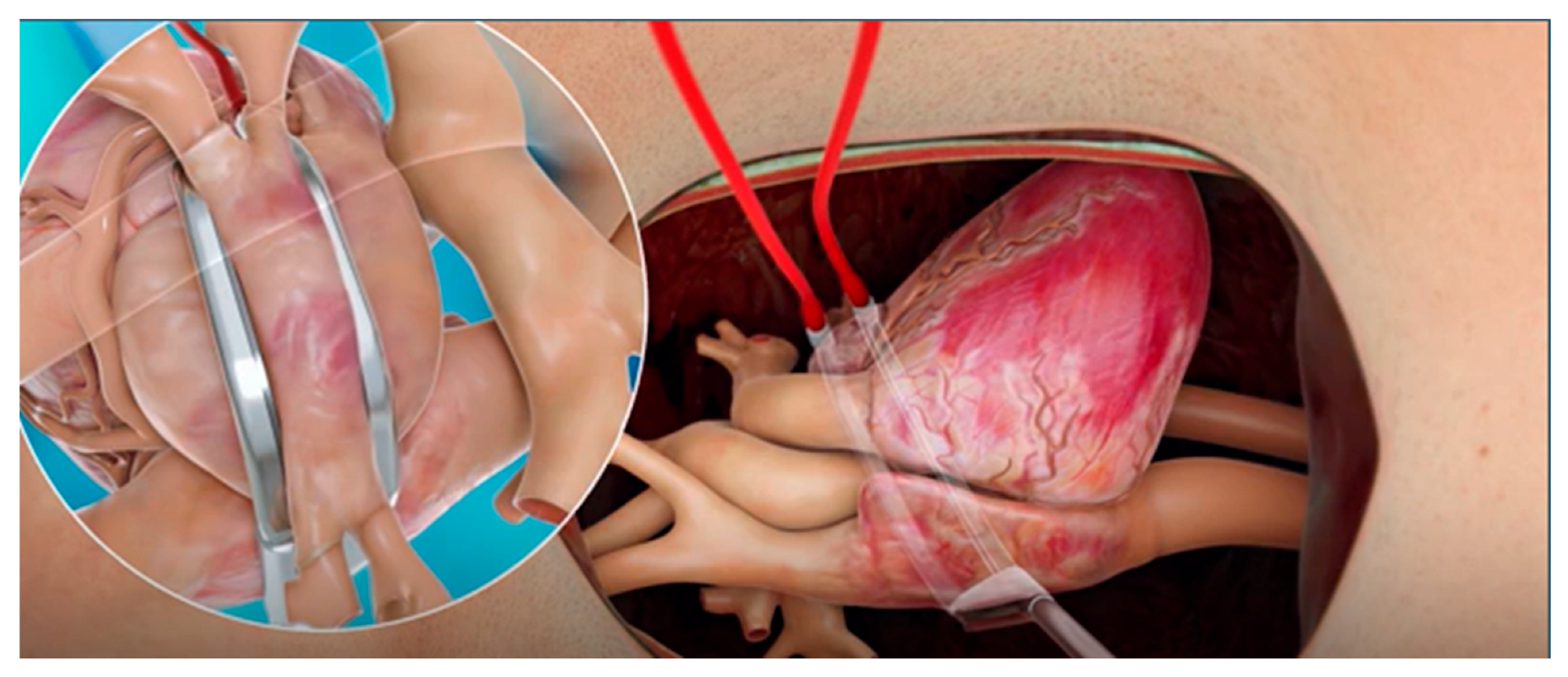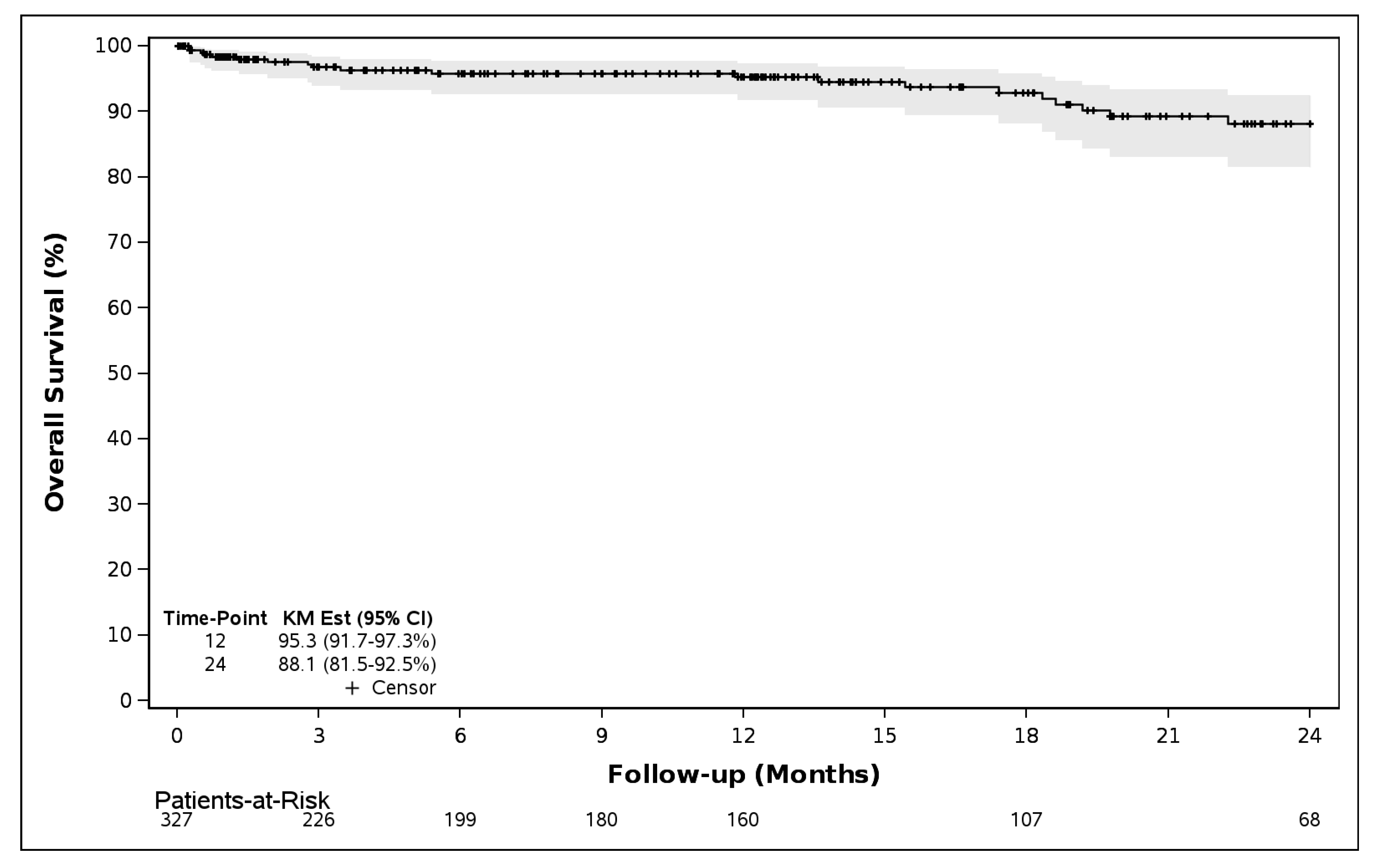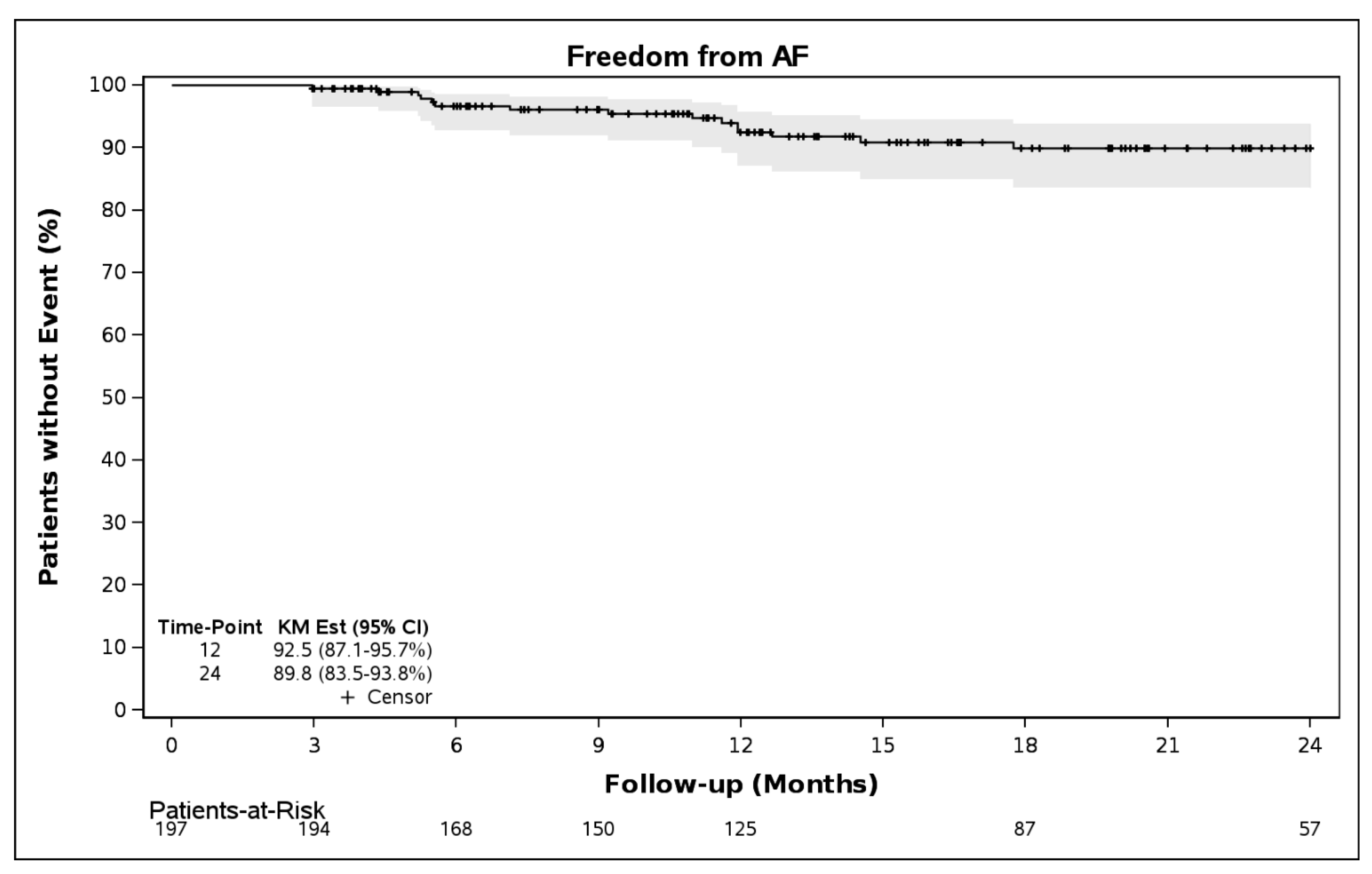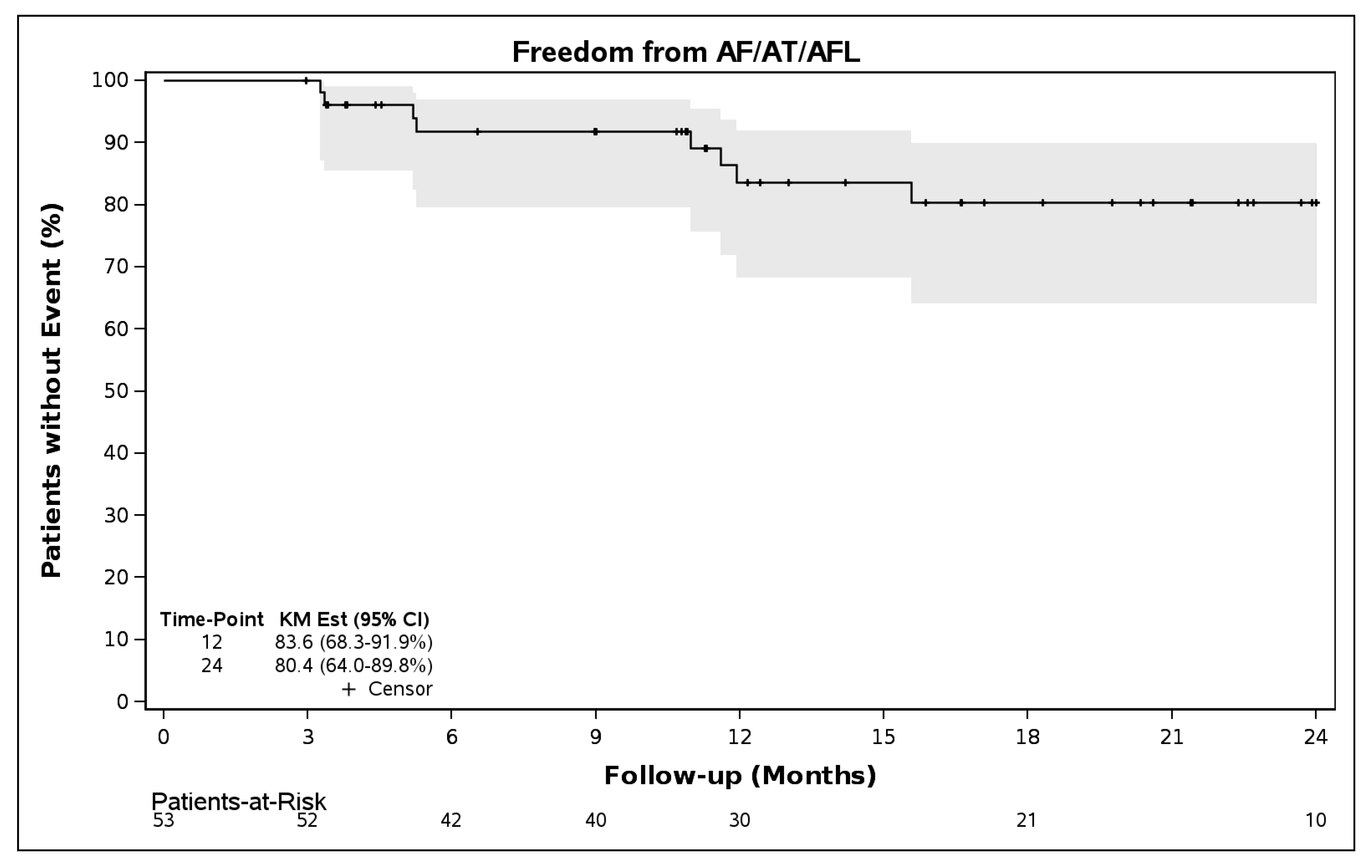Concomitant Surgical Ablation Using a Novel Bipolar Radiofrequency Clamp: Outcomes from the TRAC-AF Registry
Abstract
1. Introduction
2. Patients and Methods
2.1. Study Design
2.2. Data Collection
2.3. Statistical Methods
2.4. Surgical Procedures and Techniques
3. Results
3.1. Baseline Characteristics
3.2. Cardiac Surgeries and Ablations Performed
3.3. Survival
3.4. Follow up and Rhythm Outcomes
3.5. Safety
4. Discussion
5. Conclusions
Supplementary Materials
Author Contributions
Funding
Institutional Review Board Statement
Informed Consent Statement
Data Availability Statement
Acknowledgments
Conflicts of Interest
Abbreviations
| AF | Atrial fibrillation |
| AFL | Atrial flutter |
| AT | Atrial tachycardia |
| AVR/r | Aortic valve repair/replacement |
| CABG | Coronary artery bypass graft |
| LAA | Left atrial appendage |
| MVR/r | Mitral valve repair/replacement |
| PPM | Permanent pacemaker |
| RF | Radiofrequency |
| SAE | Serious adverse event |
| TRAC-AF | Tracking Results of Ablation to Combat AF |
| TVR/r | Tricuspid valve repair/replacement |
References
- Chen, L.Y.; Benditt, D.G.; Alonso, A. Atrial fibrillation and its association with sudden cardiac death. Circ. J. 2014, 78, 2588–2593. [Google Scholar] [CrossRef] [PubMed]
- Miyasaka, Y.; Barnes, M.E.; Bailey, K.R.; Cha, S.S.; Gersh, B.J.; Seward, J.B.; Tsang, T.S. Mortality trends in patients diagnosed with first atrial fibrillation: A 21-year community-based study. J. Am. Coll. Cardiol. 2007, 49, 986–992. [Google Scholar] [CrossRef]
- Dorian, P.; Jung, W.; Newman, D.; Paquette, M.; Wood, K.; Ayers, G.M.; Camm, J.; Akhtar, M.; Luderitz, B. The impairment of health-related quality of life in patients with intermittent atrial fibrillation: Implications for the assessment of investigational therapy. J. Am. Coll. Cardiol. 2000, 36, 1303–1309. [Google Scholar] [CrossRef] [PubMed]
- Kannel, W.B.; Wolf, P.A.; Benjamin, E.J.; Levy, D. Prevalence, incidence, prognosis, and predisposing conditions for atrial fibrillation: Population-based estimates. Am. J. Cardiol. 1998, 82, 2N–9N. [Google Scholar] [CrossRef]
- Pellman, J.; Sheikh, F. Atrial fibrillation: Mechanisms, therapeutics, and future directions. Compr. Physiol. 2015, 5, 649–665. [Google Scholar] [CrossRef]
- Blackshear, J.L.; Odell, J.A. Appendage obliteration to reduce stroke in cardiac surgical patients with atrial fibrillation. Ann. Thorac. Surg. 1996, 61, 755–759. [Google Scholar] [CrossRef] [PubMed]
- Linz, D.; Gawalko, M.; Betz, K.; Hendriks, J.M.; Lip, G.Y.H.; Vinter, N.; Guo, Y.; Johnsen, S. Atrial fibrillation: Epidemiology, screening and digital health. Lancet Reg. Health Eur. 2024, 37, 100786. [Google Scholar] [CrossRef]
- Colilla, S.; Crow, A.; Petkun, W.; Singer, D.E.; Simon, T.; Liu, X. Estimates of current and future incidence and prevalence of atrial fibrillation in the U.S. adult population. Am. J. Cardiol. 2013, 112, 1142–1147. [Google Scholar] [CrossRef]
- Lippi, G.; Sanchis-Gomar, F.; Cervellin, G. Global epidemiology of atrial fibrillation: An increasing epidemic and public health challenge. Int. J. Stroke 2021, 16, 217–221. [Google Scholar] [CrossRef]
- Attaran, S.; Saleh, H.Z.; Shaw, M.; Ward, A.; Pullan, M.; Fabri, B.M. Does the outcome improve after radiofrequency ablation for atrial fibrillation in patients undergoing cardiac surgery? A propensity-matched comparison. Eur. J. Cardiothorac. Surg. 2012, 41, 806–810, discussion 810-801. [Google Scholar] [CrossRef]
- Lee, R.; McCarthy, P.M.; Wang, E.C.; Vaduganathan, M.; Kruse, J.; Malaisrie, S.C.; McGee, E.C., Jr. Midterm survival in patients treated for atrial fibrillation: A propensity-matched comparison to patients without a history of atrial fibrillation. J. Thorac. Cardiovasc. Surg. 2012, 143, 1341–1351, discussion 1350–1341. [Google Scholar] [CrossRef]
- Louagie, Y.; Buche, M.; Eucher, P.; Schoevaerdts, J.C.; Gerard, M.; Jamart, J.; Blommaert, D. Improved patient survival with concomitant Cox Maze III procedure compared with heart surgery alone. Ann. Thorac. Surg. 2009, 87, 440–446. [Google Scholar] [CrossRef]
- Ad, N.; Damiano, R.J., Jr.; Badhwar, V.; Calkins, H.; La Meir, M.; Nitta, T.; Doll, N.; Holmes, S.D.; Weinstein, A.A.; Gillinov, M. Expert consensus guidelines: Examining surgical ablation for atrial fibrillation. J. Thorac. Cardiovasc. Surg. 2017, 153, 1330–1354 e1331. [Google Scholar] [CrossRef]
- Whitlock, R.P.; Belley-Cote, E.P.; Paparella, D.; Healey, J.S.; Brady, K.; Sharma, M.; Reents, W.; Budera, P.; Baddour, A.J.; Fila, P.; et al. Left Atrial Appendage Occlusion during Cardiac Surgery to Prevent Stroke. N. Engl. J. Med. 2021, 384, 2081–2091. [Google Scholar] [CrossRef] [PubMed]
- Wyler von Ballmoos, M.C.; Hui, D.S.; Mehaffey, J.H.; Malaisrie, S.C.; Vardas, P.N.; Gillinov, A.M.; Sundt, T.M.; Badhwar, V. The Society of Thoracic Surgeons 2023 Clinical Practice Guidelines for the Surgical Treatment of Atrial Fibrillation. Ann. Thorac. Surg. 2024, 118, 291–310. [Google Scholar] [CrossRef]
- Cox, J.L.; Canavan, T.E.; Schuessler, R.B.; Cain, M.E.; Lindsay, B.D.; Stone, C.; Smith, P.K.; Corr, P.B.; Boineau, J.P. The surgical treatment of atrial fibrillation. II. Intraoperative electrophysiologic mapping and description of the electrophysiologic basis of atrial flutter and atrial fibrillation. J. Thorac. Cardiovasc. Surg. 1991, 101, 406–426. [Google Scholar] [CrossRef] [PubMed]
- Gaynor, S.L.; Diodato, M.D.; Prasad, S.M.; Ishii, Y.; Schuessler, R.B.; Bailey, M.S.; Damiano, N.R.; Bloch, J.B.; Moon, M.R.; Damiano, R.J., Jr. A prospective, single-center clinical trial of a modified Cox maze procedure with bipolar radiofrequency ablation. J. Thorac. Cardiovasc. Surg. 2004, 128, 535–542. [Google Scholar] [CrossRef] [PubMed]
- Yates, T.A.; McGilvray, M.; Razo, N.; McElligott, S.; Melby, S.J.; Zemlin, C.; Damiano, R.J., Jr. Efficacy of a Novel Bipolar Radiofrequency Clamp: An Acute Porcine Model. Innovations 2022, 17, 409–415. [Google Scholar] [CrossRef]
- Khalpey, Z.; Aslam, U.; Kumar, U.; Epting, L. First-in-Man Use of Intraoperative Electrophysiological Mapping to Evaluate the Efficacy of the EnCompass Clamp During a Cox-IV Maze Procedure. Cureus 2024, 16, e66131. [Google Scholar] [CrossRef]
- Torregrossa, G.; Baudo, M.; Yakobitis, A.M.; Murray, C.E.; Kiankhooy, A. Isolator Synergy EnCompass clamp: Surgical notes. Ann. Cardiothorac. Surg. 2024, 13, 184–186. [Google Scholar] [CrossRef]
- Kiankhooy, A.; Rushing, G.; Pelletier, M.; Mehaffey, J.H.; Gomez-Tschrnko, M.; Gerdisch, M.; Barksdale, A.; Parikshak, M.; Chung, J.; Arora, Y.; et al. Non-Atriotomy Surgical Ablation is Safe and Effective: A Multicenter Study. In Proceedings of the STS Coronary Congress, Chicago, IL, USA, 12–14 June 2025. [Google Scholar]
- Makati, K.J.; Sherman, A.; Cox, J.L. Tampa 2 Maze: Novel Left Heart Lesion Set Using New Isolation Clamp & Cryoablation Lines, Validated With High-resolution Mapping. In Proceedings of the International Society for Minimally Invasive Cardiothoracic Surgery Annual Scientific Meeting, Athens, Greece, 29 May–1 June 2024. [Google Scholar]
- Rushing, G.D.; Ruda-Vega, P.F. Mid-Term follow-up (24 month) of concomitant non-atriotomy surgical ablation (GP-Maze) during coronary surgical revascularization. In Proceedings of the STS Coronary Congress, Chicago, IL, USA, 12–14 June 2025. [Google Scholar]
- Iribarne, A.; Zwischenberger, B.; Hunter Mehaffey, J.; Kaneko, T.; Wyler von Ballmoos, M.C.; Jacobs, J.P.; Krohn, C.; Habib, R.H.; Parsons, N.; Badhwar, V.; et al. The Society of Thoracic Surgeons Adult Cardiac Surgery Database: 2024 Update on National Trends and Outcomes. Ann. Thorac. Surg. 2025, 119, 1139–1150. [Google Scholar] [CrossRef] [PubMed]
- Badhwar, V.; Rankin, J.S.; Ad, N.; Grau-Sepulveda, M.; Damiano, R.J.; Gillinov, A.M.; McCarthy, P.M.; Thourani, V.H.; Suri, R.M.; Jacobs, J.P.; et al. Surgical Ablation of Atrial Fibrillation in the United States: Trends and Propensity Matched Outcomes. Ann. Thorac. Surg. 2017, 104, 493–500. [Google Scholar] [CrossRef]
- Kowalewski, M.; Dabrowski, E.J.; Kurasz, A.; Swieczkowski, M.; Raffa, G.M.; Kawczynski, M.; Aerts, L.; Kuzma, L.; Wanha, W.; Batko, J.; et al. Surgical ablation of atrial fibrillation with concomitant cardiac surgery: A state-of-the-art review. Eur. J. Cardiothorac. Surg. 2025, 67, ezaf187. [Google Scholar] [CrossRef]
- Wang, X.; Wang, C.; Ye, M.; Lin, J.; Jin, J.; Hu, Q.; Zhu, C.; Chen, B. Left atrial concomitant surgical ablation for treatment of atrial fibrillation in cardiac surgery: A meta-analysis of randomized controlled trials. PLoS ONE 2018, 13, e0191354. [Google Scholar] [CrossRef]
- Nisivaco, S.; Lysyy, T.; Kruse, J.; Cox, J.L.; Malaisrie, S.C. Surgical treatment of atrial fibrillation in coronary artery bypass grafting. J. Thorac. Cardiovasc. Surg. 2025, 170, 1439–1446. [Google Scholar] [CrossRef] [PubMed]
- Khiabani, A.J.; Adademir, T.; Schuessler, R.B.; Melby, S.J.; Moon, M.R.; Damiano, R.J., Jr. Management of Atrial Fibrillation in Patients Undergoing Coronary Artery Bypass Grafting: Review of the Literature. Innovations 2018, 13, 383–390. [Google Scholar] [CrossRef] [PubMed]
- Aguilar, M.; Macle, L.; Deyell, M.W.; Yao, R.; Hawkins, N.M.; Khairy, P.; Andrade, J.G. Influence of Monitoring Strategy on Assessment of Ablation Success and Postablation Atrial Fibrillation Burden Assessment: Implications for Practice and Clinical Trial Design. Circulation 2022, 145, 21–30. [Google Scholar] [CrossRef]






| Characteristic | Total Treated (N = 327) |
|---|---|
| Age, years | |
| Mean ± SD (n) | 68.1 ± 8.8 (327) |
| Median (Q1, Q3) | 69.0 (63.0, 75.0) |
| Sex | |
| Female | 29.7% (97/327) |
| Male | 70.3% (230/327) |
| Body mass index, kg/m2 | |
| Mean ± SD (n) | 30.9 ± 7.0 (326) |
| Median (Q1, Q3) | 29.8 (26.3, 34.5) |
| Atrial fibrillation type | |
| Early Persistent | 2.8% (9/327) |
| Long-Standing Persistent | 5.2% (17/327) |
| Paroxysmal | 69.4% (227/327) |
| Persistent | 14.1% (46/327) |
| Unknown | 8.6% (28/327) |
| CHA2DS2-VASc score | |
| Mean ± SD (n) | 3.3 ± 1.5 (327) |
| Median (Q1, Q3) | 3.0 (2.0, 4.0) |
| HAS-BLED score | |
| Mean ± SD (n) | 2.2 ± 1.3 (327) |
| Median (Q1, Q3) | 2.0 (1.0, 3.0) |
| Medical History | |
| Previous stroke/TIA | 11.6% (38/327) |
| Diabetes | 35.8% (117/327) |
| Heart failure | 39.8% (130/327) |
| Chronic obstructive pulmonary disease | 10.7% (35/327) |
| Coronary heart disease | 50.2% (164/327) |
| Sleep apnea | 20.8% (68/327) |
| Smoking/tobacco use history | 37.0% (121/327) |
| Hypertension | 85.9% (281/327) |
| Previous cardioversions | 18.7% (61/327) |
| Previous catheter ablations | 8.6% (28/327) |
| 1 | 6.1% (20/327) |
| 2 | 0.9% (3/327) |
| 3+ | 0.6% (2/327) |
| Unknown | 0.9% (3/327) |
| Left Ventricular Ejection Fraction (%) | |
| Mean ± SD (n) | 50.6 ± 13.5 (238) * |
| Median (Q1, Q3) | 55.0 (40.0, 60.0) |
| Left Atrial Diameter (cm) | |
| Mean ± SD (n) | 4.1 ± 1.0 (160) * |
| Median (Q1, Q3) | 4.1 (3.4, 4.7) |
| Cardiac Procedure Types | % (n/N) |
|---|---|
| Isolated CABG | 50.5% (165/327) |
| Isolated Aortic Valve replacement/repair (AVR/r) | 11.0% (36/327) |
| Isolated Mitral Valve replacement/repair (MVR/r) | 8.9% (29/327) |
| AVR/r + CABG | 8.0% (26/327) |
| MVR/r + CABG | 5.2% (17/327) |
| AVR/r + MVR/r | 1.5% (5/327) |
| Aortic Aneurysm * | 6.7% (22/327) |
| Tricuspid Valve replacement/repair (TVR/r) | 5.5% (18/327) |
| Other | 2.8% (9/327) |
| Concomitant Procedures | % (n/N) |
|---|---|
| Box lesion *, no additional lesions | 56.0% (183/327) |
| Box lesion * + Additional left-sided lesions | 18.7% (61/327) |
| Box lesion * + Additional right-sided lesions | 7.6% (25/327) |
| Box lesion * + Both left- and right-sided lesions | 17.7% (58/327) |
| Box lesion * + Full left-sided maze | 0.3% (1/327) |
| Concomitant LAA exclusion | 98.2% (320/326) |
| AtriClip | 98.1% (314/320) |
| Surgical Stapling | 0.9% (3/320) |
| Surgical Amputation | 0.3% (1/320) |
| Surgical Ligation | 0.3% (1/320) |
| Penditure™ | 0.3% (1/320) |
| All Patients (N = 198) | Paroxysmal AF (N = 141) | Non-Paroxysmal AF (N = 31) | |
|---|---|---|---|
| Freedom from AF/AT/AFL: | 87.4% (81.3–91.6) | 89.4% (82.4–93.7) | 80.5% (58.5–91.6) |
| Freedom from AF: | 92.5% (87.1–95.7) | 96.6% (91.2–98.7) | 80.5% (58.5–91.6) |
Disclaimer/Publisher’s Note: The statements, opinions and data contained in all publications are solely those of the individual author(s) and contributor(s) and not of MDPI and/or the editor(s). MDPI and/or the editor(s) disclaim responsibility for any injury to people or property resulting from any ideas, methods, instructions or products referred to in the content. |
© 2025 by the authors. Licensee MDPI, Basel, Switzerland. This article is an open access article distributed under the terms and conditions of the Creative Commons Attribution (CC BY) license (https://creativecommons.org/licenses/by/4.0/).
Share and Cite
Shults, C.; Kiankhooy, A.; Holden, S.B.; Patel, H.D.; van Wagenberg, F.; Dunnington, G.H.; Samayoa, A.; Wright, T.; Sherman, A.J.; Sievers, E.; et al. Concomitant Surgical Ablation Using a Novel Bipolar Radiofrequency Clamp: Outcomes from the TRAC-AF Registry. J. Clin. Med. 2025, 14, 8360. https://doi.org/10.3390/jcm14238360
Shults C, Kiankhooy A, Holden SB, Patel HD, van Wagenberg F, Dunnington GH, Samayoa A, Wright T, Sherman AJ, Sievers E, et al. Concomitant Surgical Ablation Using a Novel Bipolar Radiofrequency Clamp: Outcomes from the TRAC-AF Registry. Journal of Clinical Medicine. 2025; 14(23):8360. https://doi.org/10.3390/jcm14238360
Chicago/Turabian StyleShults, Christian, Armin Kiankhooy, Shaf B. Holden, Hetal D. Patel, Frans van Wagenberg, Gansevoort H. Dunnington, Andres Samayoa, Theodore Wright, Andrew J. Sherman, Eric Sievers, and et al. 2025. "Concomitant Surgical Ablation Using a Novel Bipolar Radiofrequency Clamp: Outcomes from the TRAC-AF Registry" Journal of Clinical Medicine 14, no. 23: 8360. https://doi.org/10.3390/jcm14238360
APA StyleShults, C., Kiankhooy, A., Holden, S. B., Patel, H. D., van Wagenberg, F., Dunnington, G. H., Samayoa, A., Wright, T., Sherman, A. J., Sievers, E., Kime, A., Newman, J., Barksdale, A., Baugh, J. N., Abu-Omar, Y., Rushing, G., & Gerdisch, M., on behalf of the TRAC-AF Investigators. (2025). Concomitant Surgical Ablation Using a Novel Bipolar Radiofrequency Clamp: Outcomes from the TRAC-AF Registry. Journal of Clinical Medicine, 14(23), 8360. https://doi.org/10.3390/jcm14238360







